Picture, if you will, a universe where the wilderness thunders with might and magic. This is the world of Norse mythology, a cosmos teeming with gods, giants, elves, and dwarves. At the heart of this cosmos lies Yggdrasil, the world tree, whose branches reach into each of the nine realms. One of which is Jotunheim, or Jötunheimr in Old Norse, home to the jotnar.
The name itself tells a story, for it translates to “Giant’s Home.” And giants, my friends, are what Jotunheim is all about. So buckle up, because as you will find, so many of the greatest Norse stories originate in the realm of the giants.
Understanding Norse Cosmology
Norse cosmology is a marvel of imagination. Imagine, for a moment, Yggdrasil, the world tree. Its branches and roots stretch out to hold nine distinct realms, each home to different beings. From the shining halls of Asgard to the human realm of Midgard, each world is a universe unto itself.
Jotunheim is one of these nine realms. There are a few different ideas of how the world looked according to Norse mythology. The one I believe in is that Midgard lies in the middle, surrounded by a great ocean, home to Jörmungand. Outside that world-encircling ocean lies the great mountains of Jotunheim, again encircling the world of man. It’s a place apart, a realm of raw power and primal energy, where the wild reigns supreme.
And the importance of Jotunheim cannot be overstated. As the dwelling place of the giants or Jotnar, it represents a force of chaos and untamed nature in stark contrast to the divine order of realms like Asgard. It is this balance – this tension – that adds depth and complexity to the Norse cosmos.
The Inhabitants of Jotunheim: The Jotnar
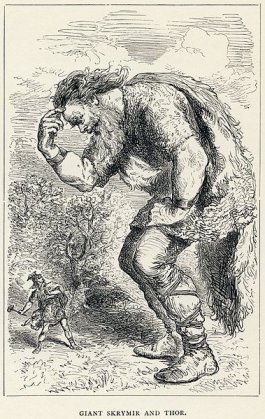
The Jotnar, or giants, are the inhabitants of Jotunheim. These beings are an interesting bunch. A stereotypical view of the jotnar is that they are giants and trolls, but in Norse mythology, they’re so much more. They come in all shapes and sizes, from the beautiful Gerdr, wife to Freyr, to Tyr’s giant troll grandmother with nine hundred heads.
They embody the wild, the elemental, the primal forces of the cosmos.
The giants of Jotunheim are typically frost giants, born of ice and cold, while fire giants inhabit the fiery realm of Muspelheim. Yet despite their elemental natures, the Jotnar are not merely brutish monsters. They possess a range of personalities and abilities, some demonstrating wisdom, cunning, and even a touch of the divine.
Notable Jotnar abound in Norse mythology. There’s Thrymr, the king of the giants, who dared to steal Thor’s hammer. Then there’s the wise Mimir, guardian of the well of wisdom, and Skadi, the ski-loving giantess of winter. Each giant brings their own flavor to the mythic brew.
And the relationships among the Jotnar are as varied as the giants themselves.
There are rivalries and alliances, friendships and feuds. The Jotnar even have complex relationships with the gods, filled with tension and intrigue. It’s these interactions that add a touch of drama to the frosty realm of Jotunheim.
The Landscape of Jotunheim
Jotunheim is a realm of rugged beauty. It’s a land of towering mountains, deep forests, and coursing rivers. The climate here is harsh, marked by biting cold and lashing winds. Yet, it’s this very wildness that gives Jotunheim its unique charm.
Among the notable locations in Jotunheim, Utgard stands out. This stronghold of the giants is a place of mystery and might, often featuring in tales of gods and giants. Then there are the various homes of known Jotnar, scattered across the realm, from Thrymheim, the abode of Thiazi, to Gastropnir, home of the giantess Menglöd.
The rivers of Jotunheim are no less noteworthy, their icy currents born from the great serpent Jörmungandr. These include the Elivagar, eleven rivers that existed even before the creation of the world. Each geographical feature of Jotunheim adds to its raw and untamed character.
Jotunheim in the Eddas
To truly understand Jotunheim, we must delve into the Eddas, the most important sources of Norse mythology. The Poetic Edda and the Prose Edda, both penned in the 13th century, offer invaluable insights into the Norse cosmos.
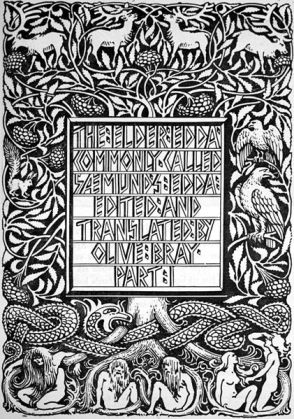
The Poetic Edda, a collection of Old Norse poems, and the Prose Edda, a manual of poetics with mythological themes, both depict Jotunheim with unique perspectives. While the Poetic Edda often portrays the realm through the grandeur of its ancient poetic verses, the Prose Edda offers a more direct narrative.
The contrast in Jotunheim’s depiction in the two Eddas is fascinating. The Poetic Edda’s imagery often emphasizes the wild and chaotic nature of Jotunheim, while the Prose Edda provides a more structured account of its geography and its inhabitants.
Jotunheim is mentioned and described several times in the Eddas. These texts paint a picture of a realm that, while harsh and untamed, is an integral part of the Norse cosmos. Whether it’s the descriptions of its frosty landscape or the tales of the giants who call it home, Jotunheim comes alive in the verses of the Eddas.
Key Events and Myths Associated with Jotunheim
Norse mythology brims with tales of Jotunheim and its inhabitants. I’m listing some of these ancient myths here, each one a window into the realm of giants.
Vafthruthnirsmal
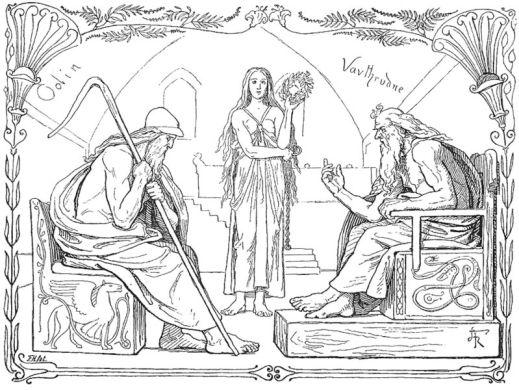
In the poem Vafthruthnirsmal, we learn how Odin, the Allfather himself, ventures into Jotunheim. He seeks out the giant Vafthruthnir, renowned for his wisdom, in a quest for knowledge. This shows even the gods respected the wisdom some giants possessed.
The encounter between Odin and Vafthruthnir is a source of fascinating insights into Norse cosmology. It reveals a wealth of information about the creation of the world, the fate of the gods, and yes, about Jotunheim and the giants.
Play Jötunn Quiz
Do you want to learn more about the magical and powerful Jötunn? Then test your knowledge with this fun quiz game!
Don’t forget to play our other games as well!
The Theft of Thor’s Hammer
In another poem from the Poetic Edda, the Thrymskvida, Thrym, the king of the giants, steals Thor’s hammer Mjölnir. The theft of this powerful weapon sends shockwaves through the realms, highlighting the audacity of the giants and the constant tension between them and the gods.
This event has a profound impact on the Norse mythos. The subsequent quest of Thor and Loki to retrieve Mjölnir reveals not only the daring of the giants but also the cunning and might of the gods. It’s a story that underscores the dynamic relationship between Jotunheim and Asgard.
Hymir’s Cauldron
In the Hymiskvida, found in the Poetic Edda, we hear of the time Thor and Tyr traveled together to Jotunheim. They were going there to borrow, or take by force, a large cauldron for brewing mead that Aegir needed.
The poem gives an interesting view into how the Aesir and jötun races are intertwined. It also shows how while some giants are beautiful or ordinary looking, some are hideous trolls with multiple heads.
Thor’s Duel with Hrungnir
In yet another interesting tale we learn about the sometimes strange dynamic between the Aesir and the jotnar. On a ride, Odin meets a jötun named Hrungnir, they make a friendly life or death wager about their horses.
Complications ensue as Odin escapes back into the relative safety of Asgard, Hrungnir following right behind. He and Thor later agree on a duel in which poor Hrungnir will lose his life. It is all retold in the story of Thor’s duel with Hrungnir.
Freyr Courting Gerdr
In another tale, told in the Poetic Edda poem Skirnismál, the god Freyr falls in love with the jötun Gerdr. Their courtship is a tale of love and longing that transcends the boundaries between realms. It’s a testament to the connections that exist between gods and giants, despite their differences.
The union between Freyr and Gerdr is significant. It symbolizes the potential for harmony between the divine and the wild, between order and chaos. It reminds us that even in a cosmos filled with conflict, there’s room for unity and love.
Thórsdrápa
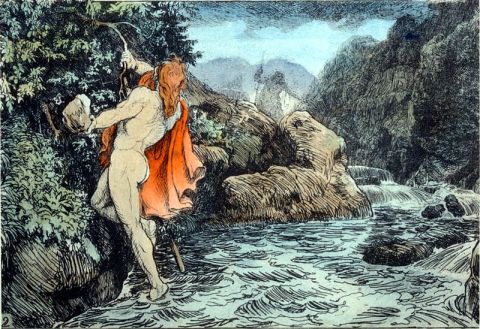
The skaldic poem Thórsdrápa (Lay of Thor) is found in a couple of old manuscripts as well as being included in full as part of Snorri’s Skáldskaparmál.
The poem recounts a story where Thor, aided by his servant Thjalfi, travels to Jotunheim to meet the jötun Geirröd. On the way there, Thor is lent, or given a few choice enchanted artifacts that will prove helpful. They are the belt of strength, the Megingjord, and the iron gloves Jãrngreipr as well as the magical staff Gríðarvölr.
Thjazi Kidnapping Idunn
Finally, let’s revisit the tale of the giant Thjazi kidnapping Idunn, the goddess who guards the apples of immortality. This event sends shockwaves across the realms, leading to a thrilling quest for Idunn’s rescue.
The kidnapping of Idunn underscores the audacity of the giants, their willingness to defy the gods for their own ends. Yet it also reveals the courage and resourcefulness of the gods, adding to the rich tapestry of Norse mythology. Starting with Loki being captured by the Jötun Thjazi, he later had to return to Jotunheim to free her.
The Role of Jotunheim in Ragnarok
Ragnarok, the prophesied apocalypse in Norse mythology, is an event of immense importance. It’s a time of cataclysmic battles, heroic stands, and profound transformations. And in this grand spectacle, Jotunheim and its inhabitants play a pivotal role.
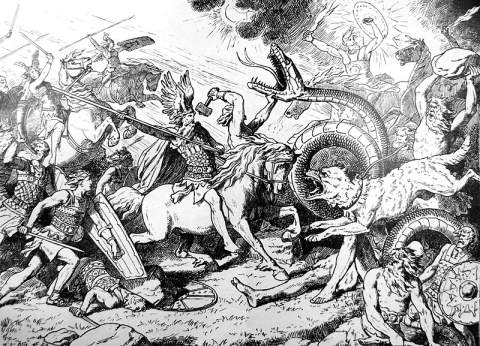
The giants of Jotunheim march against the gods during Ragnarok. Their involvement underlines the elemental conflict between order and chaos, a theme that runs deep in Norse mythology.
Following Ragnarok, the fate of Jotunheim is uncertain. The old world is swept away, making room for a new world to emerge. Yet, the essence of Jotunheim, the primal force it embodies, is eternal. As long as there’s a cosmos, there will always be a realm that resonates with the wild energy of the giants.
Interpretations and Symbolism of Jotunheim
Jotunheim, in the context of Norse cosmology and culture, is a symbol of the untamed and the primal. It represents the forces of nature in their rawest form, a stark contrast to the divine order of Asgard.
The realm also embodies the concept of the “outside” or “other.” It is the chaos beyond the orderly boundaries of the gard (meaning fence or enclosure). In this sense, both As-gard, and Mid-gard are inside of an enclosure, while Jotunheim is outside. It reminds us that the world, in all its diversity, includes elements of the wild and the civilized, the chaotic and the orderly.
Scholarly interpretations of Jotunheim vary. Some view it as a metaphor for the untamed wilderness that the ancient Norse people encountered in their daily lives. Others see it as a symbol of the psychological “other,” a realm of the mind that is as wild and untamed as the giants themselves.
Conclusion
Jotunheim, with its frosty landscapes and mighty giants, is a realm of intrigue and wonder. It’s a world that stands in stark contrast to the divine realms, yet is integral to the Norse cosmos. It’s a testament to the power of the wild, the primal, and the elemental.
So, as we conclude our journey, let’s remember Jotunheim for what it truly is – a realm that encapsulates the spirit of the Norse cosmos, a world where the wild thunders with might and magic. It’s a reminder of our own connection to the wild, a call to embrace the primal energies that reside within us all.
FAQs
Jotunheim, the realm of the giants in Norse cosmology, is a pivotal part of the Norse cosmos. It represents the forces of chaos and the untamed, standing in stark contrast to the divine order of realms like Asgard.
The Jotnar, also known as giants, are the primary inhabitants of Jotunheim. They play a significant role in Norse mythology, often engaging in conflicts with the gods, but also providing wisdom and playing key roles in various mythological events.
Jotunheimen is the name of a large montainous area in the middle of Norway. If you are planing to visit Norway, this is a great guide to one of the most iconic hikes in Jotunheimen.
Several significant events in Norse mythology are associated with Jotunheim, including the theft of Thor’s hammer by the giant Thrym, Thor and Loki’s visit to Utgard, and the giant Thjazi’s kidnapping of the goddess Idunn. Each event underscores the dynamic and often tense relationship between the gods and the giants.
During Ragnarok, the giants of Jotunheim march against the gods, symbolizing the elemental conflict between order and chaos. The fate of Jotunheim after Ragnarok is uncertain, but the realm’s essence, its primal force, is considered eternal.
Featured Image Credit: losnuevemundos via Instagram
